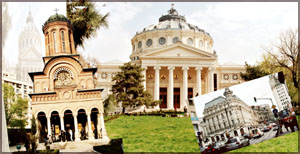
Little Blue Birdie's Diary
Dear Diary,
Today we thought of visiting Bucharest, the capital of Romania. It is
a city of contrasts and our guess is that it has always been that way
(even in the days it was known as "The little Paris").
According to Aaron, our guide bird, it is home to about 2.5 million
people. Bucharest offers a multitude of things to see and do, even if,
at first sight, it may not seem so.
Bucharest was gravely ruined during communism with most of the old
town being torn down to make way for the Soviet-style buildings that you can see today in many parts of the
city. However, most foreigners that return to Bucharest say that the
city is the kind that slowly grows on you and that if you give it more
time, it will reward you.
the Soviet-style buildings that you can see today in many parts of the
city. However, most foreigners that return to Bucharest say that the
city is the kind that slowly grows on you and that if you give it more
time, it will reward you.
Bucharest also has beautiful architecture.
The best time to visit Bucharest is in May or September. The winter
is usually very cold and Bucharest sees a lot of snow. "I like this, and
it guarantees a white Christmas every year, but if you don't like the
cold, avoid coming here from December to February", said Aaron. Summer
(July, August) is really hot (the city is located in the middle of a
plain) and it doesn't cool off much in the afternoon.
You can visit the Romanian Athenaeum (Ateneul Roman), Village Museum
(Muzeul Satului), National Art Museum (former Royal Palace), The
Parliament Palace (Palatul Parlamentului), Cismigiu Gardens (Gradina
Cismigiu), Antim Monastery and many more places in the city. We really
loved the city and spent days visiting the lovely places.
Today we visited a few of the above mentioned places. Let me write
about those separately.
The first place we visited was the Romanian Athenaeum (Ateneul
Roman). According to Aaron, this is Bucharest's most prestigious concert
hall and one of the most beautiful buildings in the city.
It was built in 1888 in neo-classical style after a design by the
French architect Albert Galleron. The project had been conceived by the
diplomat Constantin Exarcu and the money for the completion of the
building had been gathered in a public collection in which people were
asked to "give a leu for the Athenaeum" (the "leu" being the currency of
Romania).
With its 40 m high dome and Doric columns, it resembles an ancient
temple. The beautiful facade is adorned with mosaics of five Romanian
rulers. On the inside, there are scenes from Romanian history. This is
the place to hear classical music in Bucharest.
Our team enjoyed this place very much. Especially Cuckoo Bird, who is
madly in love with music, enjoyed it a lot. Next destination was the
Village Museum (Muzeul Satului). This museum had been established in
1936 and contains over 300 wooden houses, windmills and churches, from
all over the country.
"If you don't plan to visit Romania's rural areas and even if you do
you shouldn't miss this museum, which is one of the largest of its kind
in Europe", said the guard bird in the museum.
Many of the buildings are originals which had been brought here in
pieces and reassembled. The oldest houses date as far back as the 17th
century. Behind the project from the start was ethnographer Dimitrie
Gusti (1880 - 1955), who wanted the museum to mirror, as closely as
possible, aspects of rural life.
Because of this, the museum is organised as a real village, with
clusters of houses being linked by winding paths. "This makes for a
pleasant stroll, especially if you find yourself in Bucharest during the
summer, when the city is hot and dusty. Sometimes, the museum hosts
crafts fairs and folk music and dance festivals," added the guard.
Our last destination for the day was the Antim Monastery. This is a
beautiful complex built in Brancovenesque style. It was completed in
1715 after plans by Antim Ivireanu who was the metropolitan bishop of
Wallachia.
The complex is located very close to the Palace of Parliament and
similar to the Mihai Voda Church, a part of it was moved to make way for
former dictator Ceausescu's urbanisation plans. It is located behind
apartment buildings, hidden from sight.
Our journey was quite a success. We enjoyed ourselves very much and
learnt a lot about Romania. We are hoping to visit more places in
Bucharest. Until then, have a nice time!
Bye
Comments:
[email protected] |
